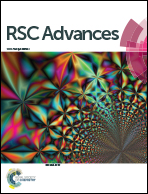Au nanoparticle decorated resin microspheres: synthesis and application in electrochemical cytosensors for sensitive and selective detection of lung cancer A549 cells†
Abstract
In this article, for the first time, we report a facile method for the synthesis and immobilization of AuNPs on m-aminophenol based resin (MAPR) microspheres via a simple reduction route. The AuNP-decorated MAPR (AuNPs/MAPR) microspheres, with a large number of active groups (amino and hydroxy groups), can not only act as suitable immobilization carriers for antibodies (EGFR antibody), but also play an important role in facilitating electron transfer. Moreover, the AuNPs/MAPR microspheres possess a high surface-enhanced Raman scattering (SERS) activity and have great potential as a SERS-active substrate. A novel electrochemical cytosensor which can sensitively differentiate lung cancer cells (A549 cells) from normal ones (AT II cells) by making use of the advantages of EGFR antibodies and AuNPs/MAPR microspheres has been designed. EGFR antibodies are immobilized on the outmost layer of the electrode surface to selectively recognize EGFR receptors that are over-expressed on lung cancer cells. The confocal microscopy images and cytotoxicity assays of the AuNPs/MAPR microspheres confirm that the prepared cytosensors exhibit good biocompatibility, high sensitivity and selectivity for the detection of A549 cells. To the best of our knowledge, this is the first cytosensor using AuNPs/MAPR microspheres as a carrier. It exhibits a broad linear range with a detection limit as low as 5 cells per mL, even in the presence of a large number of normal cells. Our study demonstrates that the proposed cytosensors can also be used to successfully determine A549 cells in diluted blood samples.


 Please wait while we load your content...
Please wait while we load your content...